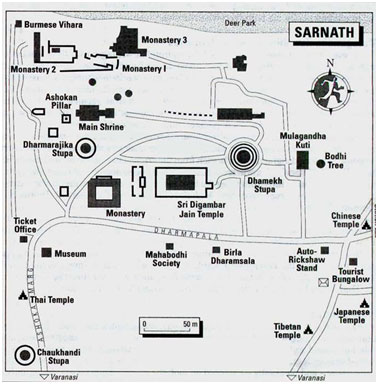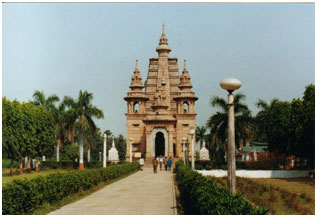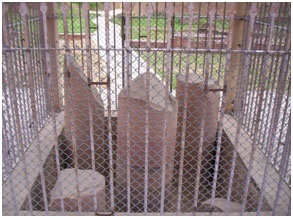Sarnath is a city located 13 kilometres north-east of Varanasi near the confluence of the Ganges and the Gomati rivers in Uttar Pradesh, India.

 Buddhists worldwide look upon India as the land of the Buddha and a visit to this country means a pilgrimage to those places sacred to the memory of the Enlightened One. After Buddha attained enlightenment in Bodh Gaya, he came to Sarnath. Here in the Deer Park, he delivered his first sermon, or in religious language, set in motion the wheel of law (maha- Dharmachakra Pravartan). On the day before his death, Buddha included Sarnath along with Lumbini, Bodh Gaya and Kushinagar as the four places he thought to be sacred to his followers.
Buddhists worldwide look upon India as the land of the Buddha and a visit to this country means a pilgrimage to those places sacred to the memory of the Enlightened One. After Buddha attained enlightenment in Bodh Gaya, he came to Sarnath. Here in the Deer Park, he delivered his first sermon, or in religious language, set in motion the wheel of law (maha- Dharmachakra Pravartan). On the day before his death, Buddha included Sarnath along with Lumbini, Bodh Gaya and Kushinagar as the four places he thought to be sacred to his followers.
Lord Buddha was born in Lumbini in Nepal. At Bodh Gaya, Lord Buddha got enlightenment. Third one is where Lord Buddha delivered his first sermon to five disciples in Sarnath here & the last one is where Lord Buddha got salvation, Nirvana, in Kushinagar. All four are revered with same respect in Buddhism. When Lord Buddha got enlightenment he thought to give his knowledge but to whom he should give his knowledge. History reveals that Varanasi at that period of time was undisputed centre of Hinduism. And for a new religion, he felt it was important that it should evolve at Varanasi. Lord Buddha travelled from Bodh Gaya to Rishipattan or Saranganath (place of deer) and gave his first sermon to Kondanna, Bhaddiya, Vappa, Mahanama, Assaji and changed the wheel of dharma. One magnificent statue in Sarnath museum present this important episode of Lord Buddha’s life. Buddhism spread throughout India and other parts of the world when King Ashoka came into power. Here in Sarnath the king established a marvellous image of four lions facing four directions joined together with the wheel of dharma. After independence, this became the national symbol of India. This statue is as well in Sarnath museum. There are three stupas in Sarnath in which two are intact while the third one has been totally diapered. The visible Stupas are Dhammek Stupa & Chaukhandi Stupa. Dhammek Stupa is an architecture of Gupta’s period. On the other hand Chaukhandi Stupa was refurbished at the period of Akbar to commemorate the stay of Humayu at this place. Excavation is in process at this site & new findings are still being unearthed. Other important place in Sarnath is excavated area around Dhammek Stupa that reveals ancient habitat of Buddhist Monks.
The Emperor Ashoka, who spread the Buddha’s message of love and compassion throughout his vast empire, visited Sarnath around BC 234. Several Buddhist structures were raised at Sarnath between third century BC and the eleventh century AD, and today it presents the most expansive ruins amongst places on the Buddhist trail. Sarnath is 10 km from the holy city of Varanasi, and is an exceedingly tranquil place. The ruins, the museum and temple are all within walking distance.
CHAUKHANDI STUPA :
 Chaukhandi is the first monument one encounters as one enters Sarnath. The most remarkable structure at Sarnath, is the cylindrical Dhamek Stupa, 28 mts in diameter at the base and 43.6 mts in height, built partly of stone and partly of brick.
Chaukhandi is the first monument one encounters as one enters Sarnath. The most remarkable structure at Sarnath, is the cylindrical Dhamek Stupa, 28 mts in diameter at the base and 43.6 mts in height, built partly of stone and partly of brick.
Sarnath yielded a rich collection of sculptures comprising numerous Buddha and Bodhisattva images. Considered amongst the finest specimens of Buddhist art, these have been housed at the museum, adjacent to the site. The museum is open from 10 am to 5 pm and closed on Fridays. Apart from the above the other objects of interest at Sarnath are the Dharmrajika Stupa, magnificent Lion capital, India’s National Emblem at Sarnath museum.
ASHOKA PILLAR
 It is at Sarnath, the Ashoka pillar stands in front of the main stupa where Ashoka sat and meditated.
It is at Sarnath, the Ashoka pillar stands in front of the main stupa where Ashoka sat and meditated.
BUDDHA PURNIMA festival at Sarnath festival celebrates the birth of Lord Buddha with traditional religious fervour. A large fair is held at Sarnath and the relic of the Buddha are taken out for public display in a procession on this day.